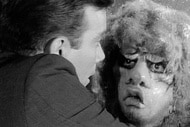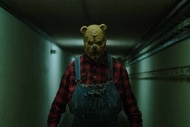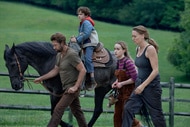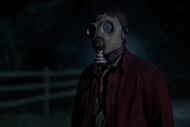An extended look at Little Hope, Supermassive's next horror game

If you look back over the last decade of releases from UK development studio Supermassive Games, the two that are best-known have a lot in common. Both 2015's Until Dawn and 2019's The Dark Pictures Anthology: Man of Medan are interactive horror games where players make choices about how a cast of young adults should act with the ultimate goal of keeping them alive. Sure, one is a ten-hour-long story about teens trapped in a scary cabin in the woods and the other is a five-hour-long game set on a spooky old military ship, but the studio clearly has a knack for telling horror stories through choice and rapid-fire quick-time events.
A couple of days ago, Supermassive formally revealed The Dark Pictures Anthology: Little Hope, another five-hour-long interactive horror game featuring much of the same gameplay formula. I personally loved Man of Medan and I've been eager to find out more about the ways the stand-alone stories being told in The Dark Pictures Anthology might end up linking together for those players who choose to experience the entire anthology.
The Dark Pictures Anthology: Little Hope takes place largely in a fictional New England town of the same name. The story follows a small group of students and their teacher on a school trip, who, in a twist that feels directly lifted from a Silent Hill game, end up in an unknown town surrounded by such dense fog that escape becomes impossible. While the core cast of characters exists in the present day, their fates are linked to an ominous past. Flashbacks show a family in the 1970s who share their faces and meet death at the hands of an Omen-esque child who orchestrates their murders, while a time travel event shows the modern-day characters coming face-to-face with people who look like them being killed as part of the 17th-century witch trials, again seemingly in connection to a young girl suspected of witchcraft.
While a planned trip to visit Supermassive Games had to be canceled due to coronavirus restrictions in the UK, I was able to watch a decent chunk of Little Hope via an online press event and interview series producer Dan McDonald about what I saw of the game.
One of the most notable differences between Little Hope and the Supermassive horror games that came before it is the rate at which it shows its hand about the nature of its horror. Both Until Dawn and Man of Medan took upwards of an hour to introduce players to who each of their characters were in a world where nothing supernatural or mysterious was yet threatening their life.
Watching through Little Hope right from the start, it's notable that we know basically nothing about our main cast of characters in the first half-hour of the game. We know that John, the professor running the class outing, has been attending some sort of addiction support meetings and keeps rubbing his three-month sobriety chip as a way to stay calm in stressful situations, but beyond that, we know basically nothing before seeing the game's instigating bus crash and ensuing flashbacks to characters from several decades prior who seem inextricably linked to the main modern-day cast. For players who go into this adventure blind, the only real clue that these characters in the past are connected to our contemporary cast is that the analog character for John in the past also has a drinking addiction, although his is less under control than his present-day counterpart.
While previous Supermassive horror titles have pretty exclusively focused on tales of young adults, widely used in horror because of their potential for reckless or ill-thought-out behavior, Little Hope shifts this formula a little, making two of its five playable characters considerably older. There's the previously mentioned John, as well as Angela, a mature student who looks like a prim and proper librarian — and, from the start of the game, seems to fill in the role of skeptic. The rest of the cast is made up of Andrew, an audience surrogate played by Midsommar actor Will Poulter; Daniel, a stereotypical angry jock; and Taylor, a seemingly caring young woman with a pixie cut who radiates queer energy. Having watched a decent chunk of gameplay, I was particularly impressed with the early performance of Poulter, who makes use very varied regional accents when voicing the various characters with who he shares a face.
Of all the characters shown to be playable in Little Hope, the character I am most interested in from an initial look at the game is Angela, in part due to her age and in part due to seeing her skepticism and fear around horror tropes confronted so early in the narrative. The previous Supermassive horror games have all put their cast of characters in situations that often require impossible choices, or place them in situations where they have to use physical skill to fight for their lives. I'm incredibly curious to see what sort of action scenarios will be able to create tension and dread while still being physically feasible for a character far older than the rest of the group. Given how quickly Angela seems to encounter supernatural events, I am curious how soon the player will have the option to pivot her completely to a belief of the situation unfolding around her.
While each game in The Dark Pictures Anthology is planned to be a stand-alone horror story, one curious exception to that is a character from Man of Medan known as The Curator, a mysterious older man who talks directly to the player and seems aware of the larger framework of the game being played and the stories being told. I asked McDonald if The Curator would acknowledge your previously played games from the anthology and what that could mean for players jumping in partway through the series to one specific stand-alone game.
"If you have played Man of Medan he will talk to you in that knowing way, and if you haven't then he won't," answered McDonald. "Our expectation is that it will be based on your save data. That's the plan. The Curator is a great character and a great plot device for us. He can talk directly to the player, he has his own story and arc to tell, and he can be a continuous part of the anthology for players who are interested... If you just jump into one stand-alone story in the middle, that doesn't have to be part of your experience."
As with Man of Medan before it, Little Hope features a series of different ways to play through its narrative. Players can either play through the five-hour campaign entirely in single player, swapping between characters as the narrative dictates; pass the controller between a group of couch co-op friends picking which characters to each control; or play through the game in online multiplayer, where each player sees the narrative from a different perspective, seeing some scenes that others do not. If Little Hope is anything like Man of Medan, and it sure seems to be, I would recommend playing through in online co-op first if possible as the added tension of knowing there are secrets and information hidden from you can lead to some additional scenes of unexpected fear.
However, Little Hope does have a few key gameplay differences from Man of Medan that were shown off in the gameplay demonstration. Rather than points of interest in the world simply showing a slight sparkle effect and no more information, the game will now tell players upfront what kind of action they will take if they interact with an item, such as examining it or picking it up. Additionally, any interaction in the world that will lead to a quick-time event is now clearly labeled and will tell you upfront what will happen if you complete the quick-time event successfully.
I asked McDonald if it was tough to walk the line between keeping players informed and keeping them scared of the unknown, an issue he seemed to be well aware of.
"It's a fine line. One of the lessons that we learned from Man of Medan is giving the player more information about their choices is generally a good thing; we want to use iconography that tells the player what will happen in an interaction if they succeed or if they fail. We don't want players walking around our world pressing the interact button every time they see a glint on screen; we want them to know what they are about to interact with, and whether they're going to look at it, pick it up, turn it over, or take it."
I followed up by asking McDonald if those prompts would always be honest with the player or if there was room for deliberate misdirection.
"A core tenant of how we make our horror games is we never want to lie to the player just to get a scare. We like to subvert and twist expectations, but we have to be careful how we do that. You might start doing something, and then something in the world around you which you were aware of might interrupt what you were trying to achieve, but we try to be careful to ask ourselves if it would have happened anyway, or did it happen because you activated that prompt?"
Narratively, Little Hope seems to throw out a lot of horror genre tropes very fast, and it's very unclear which ones are legitimate and which ones are potential red herrings. I highly suspect the narrative will not try to simultaneously tackle a 17th-century witch trial narrative where there may or may not be legitimate witches; a time-travel narrative about possibly reincarnating characters cursed to die over and over; a Silent Hill-style narrative about escaping a horrifying town steeped in fog; and an The Omen-inspired narrative about a little girl accompanied by a malevolent creature that is seemingly both powerful and influencing her to commit acts of evil against her family. I have to hope that some of these plotlines are red herrings designed as set dressing or misdirection because otherwise that feels like a lot of threads to try to later connect.
While a lot of the appeal in a piece of interactive horror is in going hands-on with it, making your own choices, and starting to see their long-term outcomes, everything I have seen of Little Hope so far feels like an attempt to keep what worked about Until Dawn and Man of Medan while avoiding breaking a formula that largely works and making mostly minor tweaks to improve quality of life complaints.
The game is due out at some point this summer and looks worth keeping an eye on if you like the idea of a horror story in which you can deliberately steer the characters who annoy you to their deaths along the way.






























